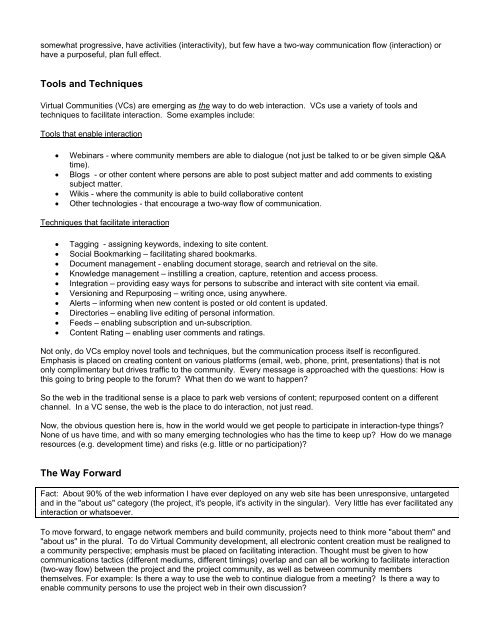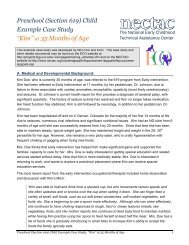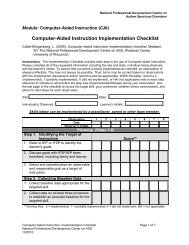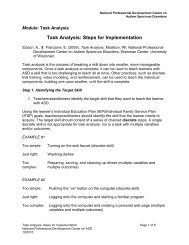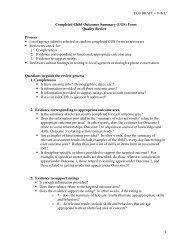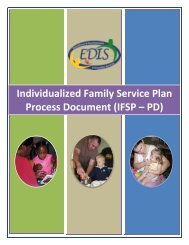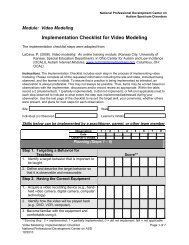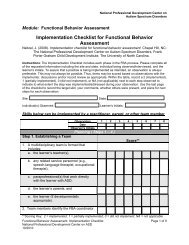somewhat progressive, have activities (interactivity), but few have a two-way communication flow (interaction) orhave a purposeful, plan full effect.Tools <strong>and</strong> Techniques<strong>Virtual</strong> <strong>Communities</strong> (VCs) are emerging as the way to do web interaction. VCs use a variety of tools <strong>and</strong>techniques to facilitate interaction. Some examples include:Tools that enable interaction• Webinars - where community members are able to dialogue (not just be talked to or be given simple Q&Atime).• Blogs - or other content where persons are able to post subject matter <strong>and</strong> add comments to existingsubject matter.• Wikis - where the community is able to build collaborative content• Other technologies - that encourage a two-way flow of communication.Techniques that facilitate interaction• Tagging - assigning keywords, indexing to site content.• Social Bookmarking – facilitating shared bookmarks.• Document management - enabling document storage, search <strong>and</strong> retrieval on the site.• Knowledge management – instilling a creation, capture, retention <strong>and</strong> access process.• Integration – providing easy ways <strong>for</strong> persons to subscribe <strong>and</strong> interact with site content via email.• Versioning <strong>and</strong> Repurposing – writing once, using anywhere.• Alerts – in<strong>for</strong>ming when new content is posted or old content is updated.• Directories – enabling live editing of personal in<strong>for</strong>mation.• Feeds – enabling subscription <strong>and</strong> un-subscription.• Content Rating – enabling user comments <strong>and</strong> ratings.Not only, do VCs employ novel tools <strong>and</strong> techniques, but the communication process itself is reconfigured.Emphasis is placed on creating content on various plat<strong>for</strong>ms (email, web, phone, print, presentations) that is notonly complimentary but drives traffic to the community. Every message is approached with the questions: How isthis going to bring people to the <strong>for</strong>um? What then do we want to happen?So the web in the traditional sense is a place to park web versions of content; repurposed content on a differentchannel. In a VC sense, the web is the place to do interaction, not just read.Now, the obvious question here is, how in the world would we get people to participate in interaction-type things?None of us have time, <strong>and</strong> with so many emerging technologies who has the time to keep up? How do we manageresources (e.g. development time) <strong>and</strong> risks (e.g. little or no participation)?The Way ForwardFact: About 90% of the web in<strong>for</strong>mation I have ever deployed on any web site has been unresponsive, untargeted<strong>and</strong> in the "about us" category (the project, it's people, it's activity in the singular). Very little has ever facilitated anyinteraction or whatsoever.To move <strong>for</strong>ward, to engage network members <strong>and</strong> build community, projects need to think more "about them" <strong>and</strong>"about us" in the plural. To do <strong>Virtual</strong> Community development, all electronic content creation must be realigned toa community perspective; emphasis must be placed on facilitating interaction. Thought must be given to howcommunications tactics (different mediums, different timings) overlap <strong>and</strong> can all be working to facilitate interaction(two-way flow) between the project <strong>and</strong> the project community, as well as between community membersthemselves. For example: Is there a way to use the web to continue dialogue from a meeting? Is there a way toenable community persons to use the project web in their own discussion?
There are literally hundreds of web interactivities to deploy, but very few that actually facilitate interaction. Why?<strong>Interaction</strong> is people, not technology, <strong>and</strong> managing interaction requires dedicated people.<strong>Virtual</strong> Community RolesRegardless of whether fulltime people are devoted to managing a <strong>Virtual</strong> Community, an underst<strong>and</strong>ing of variouscommunity roles is necessary to do/facilitate electronic interaction <strong>and</strong> build online communities.ExpertsExperts are the knowledge entrepreneurs. They are persons who spend most of their time analyzing, synthesizing,reflecting, <strong>and</strong> exp<strong>and</strong>ing on data, in<strong>for</strong>mation <strong>and</strong> group communication. They have no preferred communicationmedia because knowledge can be created anywhere. Their tech savvyness may or may not be limited, but theirnumber one constraint is time (based on the dem<strong>and</strong>s of the knowledge creation process itself). They work closelywith Content Creators to communicate their messages.Due to the elongated process of knowledge creation, experts are typically slow to adopt new tools.Content CreatorsContent Creators are persons who assimilate, filter, analyze <strong>and</strong> interpret in<strong>for</strong>mation (e.g. “mash up” or“synthesize”) as well as create <strong>and</strong> transmit communications. This is not restricted to creating web content. Theirmost valuable role is the ability to repurpose content; create email, web, presentation, print, <strong>and</strong> other versions ofcontent <strong>and</strong> ensure are all complimentary. Content Creators work with content contributors <strong>and</strong> experts to interpret<strong>and</strong> write messages that can be received, read <strong>and</strong> understood by all community members.Content Creators <strong>and</strong> are typically quick to adopt tools that speed their interpreting <strong>and</strong> production steps.Content ContributorsContent Contributors are persons who contribute content (data, in<strong>for</strong>mation, feedback) but are not tasked withversioning <strong>and</strong>/or distributing it. They are usually not interested in <strong>for</strong>mally creating content. They merely want totalk, either provide in<strong>for</strong>mation <strong>and</strong>/or feedback. They are very important to providing the critical mass that leads tobroad discussion <strong>and</strong> idea creation in a <strong>Virtual</strong> Community.Content Contributors will adopt a new tool only if it is very easy to use <strong>and</strong> integrates with exiting behavior.LurkersLurkers are persons that visit online communities <strong>and</strong> rarely, if ever, participate in any dialog or exchange. Lurkerstypically make up the largest portion of online communities <strong>and</strong> their active browsing\visitation\membership thoughinactive participation has various motivations (Hester: 2006). Motivating them is key to knowledge <strong>for</strong>mation. Eventhough they are not visibly active, their role in reading/observing community activity is valuable in to thedissemination <strong>and</strong> knowledge transfer process.Lurkers use tools to gain visibility to community activity <strong>and</strong> content. Tools typically do not motivate lurkers toactually participate in VCs as their motivations <strong>for</strong> participation vary.IT Programmers/DevelopersIT Programmer\Developers work with the community to enable interaction via technology. They develop, deploy<strong>and</strong> mange tools that facilitate the Content Creator <strong>and</strong> Contributor, tasks. They work closely with the CommunityDeveloper to underst<strong>and</strong> existing <strong>and</strong> emergent group behavior <strong>and</strong> automate routines to facilitate group activity<strong>and</strong> interaction.IT Programmers develop <strong>and</strong> deploy tools, but typically do not create content or monitor use.Community DeveloperThe role of the web community developer is nothing new. AOL has been developing online communities (e.g.health) <strong>and</strong> had persons managing them since the advent of the web browser. In mainstream web terms however,the role of online community developer is an emerging one. Web community developers are not just the personswho manage content, but persons whom manage <strong>and</strong> facilitate online interaction. This role is a complete drift fromtraditional IT developers\managers (tech orientation) <strong>and</strong> communications staff (in<strong>for</strong>mation <strong>and</strong> communications


